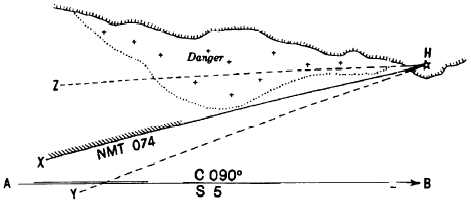| |
Planning and Constructing Restricted Water Tracks, Continued
Danger Bearings
A danger bearing is used by the navigator to keep the ship clear of an
outlying area of danger close to where the ship must pass. In all
probability, a danger area has been previously surveyed and is plotted on
the chart, but, in the vast majority of cases, it will give no warning of its
presence to the eye. Examples of such dangers are submerged rocks,
reefs, wrecks, and shoals. A danger bearing must be established
between two fixed objects, one of which is the danger area. The other
object must be selected to satisfy the following conditions: (1) It must
be visible to the eye; (2) it must be indicated on the chart; and (3) true
bearing from the danger area should be in the same general direction as
the course of the ship as it proceeds past the danger.
Figure 12-6. Example of a danger bearing.
As shown in figure 12-6, a ship is proceeding along a coast on an
intended track of 090°T at a speed of 5 knots (line AB). A shoal on the
port side is to be avoided. A line is drawn from lighthouse H, tangent
to the outer edge of the danger (line HX). As long as the bearing of
lighthouse H is less than line XH (the danger bearing), the ship is in
safe water. The danger bearing in this illustration is 074°T. You will
notice that the danger side of the danger bearing is hatched. The danger
bearing is also labeled with NMT (meaning NOT MORE THAN). An
example of a bearing to lighthouse H that would indicate that the ship is
in safe water is the broken line YH. No part of this bearing line passes
through the danger area.
Any bearing greater than the danger bearing
(line XH), such as the broken line ZH, indicates a possible dangerous
situation. If the danger area is being passed on the port side, as in this
illustration, the safe bearing is less than the danger bearing. Danger
angles are not normally used; however, you should use Pub 9, Bowditch,
to learn more about using them.
12-10
|

